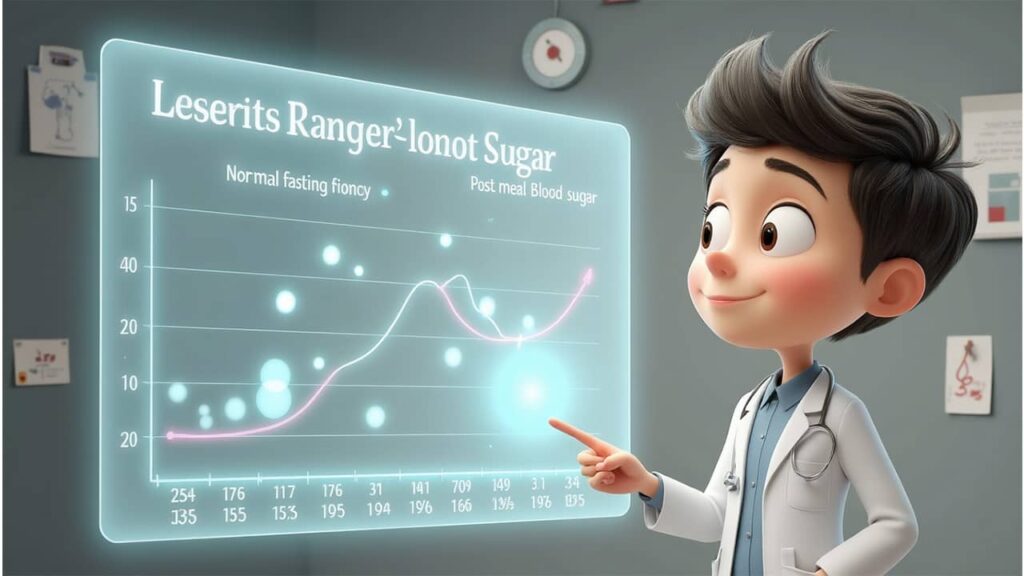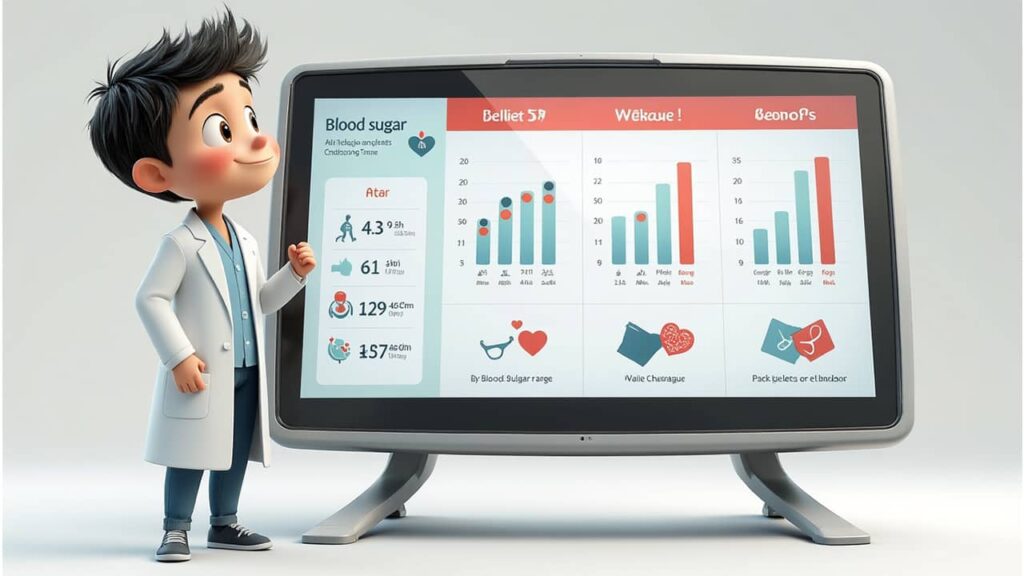Blood Sugar Levels Chart by Age: 7 Essential Ranges

Blood sugar levels chart by age is one of the most important tools you can use to understand your health and prevent complications over time.
Table of Contents
Knowing your healthy blood sugar levels by age helps you make informed lifestyle decisions and detect potential issues early.
In this guide, we’ll explore the blood sugar levels chart by age in detail, explain what’s considered normal at different life stages, and share practical tips to maintain them.
You’ll also find an A1C chart by age for long-term monitoring and understand the main factors that influence glucose stability.
For those looking to support their daily wellness routine, some people include natural supplements as part of their plan.
NuviaLab Sugar Control is one example of a tool that can complement healthy eating and regular exercise by helping maintain balanced glucose levels always as part of a comprehensive health approach, not as a substitute for medical care.
What Is a Normal Blood Sugar Level by Age?

Understanding what’s considered a normal blood sugar level by age is the first step toward keeping your health in check.
Blood glucose targets can vary depending on whether the reading is taken fasting (before eating) or postprandial (after eating), as well as on age, overall health, and individual risk factors.
For most healthy adults, fasting normal blood glucose by age typically ranges from 70 to 99 mg/dL, while post-meal values often stay below 140 mg/dL.
However, children, teenagers, and older adults may have slightly different optimal ranges due to metabolic changes and other health considerations.
Our healthy blood sugar levels by age chart available below outlines these differences clearly, helping you understand where you stand and when to take action.
If you’d like a more detailed breakdown and prevention tips, you can explore our main guide: What Is an Unsafe Blood Sugar Level? 7 Essential Facts, Symptoms, and Prevention Tips.
By knowing your target range, you can take proactive steps such as adjusting your diet, staying active, and monitoring your A1C levels to keep your glucose steady.
This knowledge, combined with healthy lifestyle choices, can significantly reduce your risk of prediabetes and diabetes.
Normal Fasting Blood Sugar Levels by Age
Fasting blood sugar refers to the glucose level measured after not eating or drinking anything (except water) for at least 8 hours.
For most healthy individuals, the normal fasting blood sugar levels by age remain between 70 and 99 mg/dL.
However, these numbers can vary slightly across different age groups:
- Children and teenagers: Often at the lower end of the range due to faster metabolism.
- Adults: Typically between 80 and 99 mg/dL before breakfast.
- Older adults: Slightly higher fasting values can be normal due to reduced insulin sensitivity.
Maintaining healthy glucose levels by age during fasting is important because prolonged elevated values may signal prediabetes or diabetes, while consistently low readings can indicate hypoglycemia.
For a complete breakdown, see our blood sugar levels chart by age later in this guide.
And for more insight into what happens when glucose goes too high or too low, check our detailed article: What Is an Unsafe Blood Sugar Level?.
Post-Meal Blood Sugar Levels by Age
Post-meal blood sugar also called postprandial glucose is measured about 1 to 2 hours after eating. These values can give a clearer picture of how your body processes carbohydrates and help detect early signs of glucose imbalance.
For most healthy adults, post-meal blood sugar levels by age should remain below 140 mg/dL.
In children and teenagers, levels often return to baseline faster, while in older adults, post-meal readings may stay elevated longer due to decreased insulin sensitivity.
Here’s a quick reference:
- Children and teens: Typically return to 120–130 mg/dL within 2 hours.
- Adults: Often stabilize under 140 mg/dL within 2 hours.
- Seniors: May see slightly higher values, but ideally should remain under 160 mg/dL.
Consistently higher post-meal numbers may signal early stages of insulin resistance or prediabetes.
Our blood sugar levels chart by age later in this article provides a full breakdown for each age group, helping you compare your results against optimal targets.
If you want to learn what happens when these levels cross unsafe thresholds, you can check our main guide: What Is an Unsafe Blood Sugar Level? 7 Essential Facts, Symptoms, and Prevention Tips.
Blood Sugar Levels Chart by Age (Complete Table)

A blood sugar levels chart by age offers a quick way to compare your current glucose readings against the recommended ranges for your age group.
These values can help you and your healthcare provider determine whether your blood sugar is within a healthy range.
Below is a sugar level chart by age that includes fasting and post-meal targets:
| Age Group | Fasting (mg/dL) | Post-Meal (mg/dL) |
|---|---|---|
| Children (6–12) | 80–100 | < 140 |
| Teens (13–19) | 80–105 | < 140 |
| Adults (20–59) | 80–99 | < 140 |
| Older Adults (60+) | 80–110 | < 160 |
📌 Source: Mayo Clinic – Blood Sugar Levels
Using this healthy blood sugar levels by age chart as a reference can guide lifestyle adjustments and inform medical discussions.
Always consult with a healthcare professional before making any significant changes to your diet, exercise, or medication plan.
A1C Level Chart by Age

An A1C level chart by age shows your average blood sugar levels over the past 2–3 months, giving a more complete picture of your glucose control than a single reading.
While daily measurements help track fluctuations, the A1C test reveals long-term patterns that can guide treatment and lifestyle adjustments.
Below is an A1C chart by age that aligns with the blood sugar levels chart by age you saw earlier:
| Age Group | A1C (%) | Estimated Average Glucose (mg/dL) |
|---|---|---|
| Children (6–12) | < 7.5 | < 169 |
| Teens (13–19) | < 7.5 | < 169 |
| Adults (20–59) | < 7.0 | < 154 |
| Older Adults (60+) | < 7.5–8.0 | < 169–183 |
📌 Source: Centers for Disease Control and Prevention – A1C Test
Keeping your healthy blood sugar levels by age within target helps maintain a favorable A1C.
If your numbers are consistently above these ranges, it’s important to consult a healthcare provider.
You can use both the blood sugar levels chart by age and the A1C chart together to monitor your progress.
Factors That Affect Blood Sugar Levels at Different Ages

Several factors can influence your blood sugar levels chart by age, making it essential to understand what might cause your readings to shift over time.
These influences can vary from one life stage to another, so knowing them can help you interpret your numbers more accurately.
- Diet and Nutrition
- The type and amount of carbohydrates you consume directly affect your healthy blood sugar levels by age. Meals high in refined sugars can cause rapid spikes, while balanced meals with fiber, protein, and healthy fats help stabilize glucose.
- 2. Physical Activity
- Exercise improves insulin sensitivity, helping your body manage glucose more effectively. The blood sugar levels chart by age often reflects better numbers in individuals who maintain regular activity levels.
- 3. Hormonal Changes
- Puberty, pregnancy, and menopause can all alter glucose metabolism. Monitoring your numbers during these periods is key to staying within the target ranges listed in the blood sugar levels chart by age.
- 4. Medications and Health Conditions
- Certain medicines, as well as conditions like high blood pressure or thyroid disorders, can impact your glucose. Discuss any changes in your readings with your healthcare provider.
📌 For more details on recognizing unsafe readings and acting early, visit our main guide: What Is an Unsafe Blood Sugar Level? 7 Essential Facts, Symptoms, and Prevention Tips.
How to Maintain Healthy Blood Sugar Levels

Keeping your healthy blood sugar levels by age within the recommended range requires a mix of smart daily habits, regular monitoring, and, when needed, professional guidance.
The tips below apply across all life stages, but each age group may need to adapt them based on their lifestyle and health status.
- 1. Balanced Diet
- Include whole grains, lean proteins, healthy fats, and plenty of vegetables. Limiting refined sugars and processed foods helps stabilize your readings and align them with the values in the blood sugar levels chart by age.
- 2. Regular Physical Activity
- Aim for at least 150 minutes of moderate-intensity exercise per week. Physical activity improves insulin sensitivity, making it easier to maintain target numbers on your blood sugar levels chart by age.
- 3. Consistent Monitoring
- Track fasting and post-meal readings, and schedule A1C tests as recommended. Comparing your results with the blood sugar levels chart by age can highlight trends and help you act early.
- 4. Stress and Sleep Management
- Chronic stress and poor sleep can raise glucose levels. Mindfulness, relaxation exercises, and consistent sleep schedules support better metabolic control.
For those seeking additional daily support, some people choose to incorporate natural supplements into their routine.
NuviaLab Sugar Control is one example of a complementary tool that can work alongside healthy eating and exercise to help keep glucose levels balanced always as part of a holistic health plan and under medical supervision.
Conclusion

Understanding and regularly checking your blood sugar levels chart by age is one of the most effective ways to protect your long term health.
Whether you’re in your teens, midlife, or senior years, knowing your target ranges empowers you to make better lifestyle decisions and spot potential problems early.
Use this guide alongside regular medical checkups to track your healthy blood sugar levels by age and make adjustments as needed.
The more consistent your readings are within the recommended ranges, the lower your risk for developing serious complications like diabetes and cardiovascular disease.
If you want to learn more about the warning signs of unsafe readings and practical prevention strategies, explore our main resource: What Is an Unsafe Blood Sugar Level? 7 Essential Facts, Symptoms, and Prevention Tips.
Remember your health is a lifelong investment, and tools like the blood sugar levels chart by age can help you stay on track.
What is the blood sugar levels chart by age?
A blood sugar levels chart by age shows recommended fasting and post-meal glucose targets for children, adults, and seniors. It helps you compare your readings with age-appropriate healthy ranges.
What are normal blood sugar levels by age in fasting?
General guidance: children/teens 80–105 mg/dL, most adults 80–99 mg/dL, and seniors 80–110 mg/dL. Targets can vary—always confirm with your healthcare provider.
What should my post-meal blood sugar be by age?
For many healthy people, post-meal (2 hours) levels stay below 140 mg/dL; in older adults, targets may be slightly higher (often under 160 mg/dL). Discuss personal goals with your clinician.
How does the A1C chart by age relate to daily readings?
The A1C chart by age reflects average glucose over 2–3 months. Keeping daily readings within the blood sugar levels chart by age usually supports an A1C near individualized targets (often ≤7.0% for many adults).
Do normal blood glucose levels by age differ for men and women?
Reference ranges are broadly similar. Hormones, body composition, and health status can influence individual targets, so personalized guidance is recommended.
Which factors affect healthy blood sugar levels by age?
Diet quality, physical activity, stress, sleep, medications (e.g., steroids), and health conditions can shift your numbers across life stages. Regular monitoring helps detect trends early.
How can I keep my blood sugar within the chart ranges?
Follow a balanced diet, stay active, monitor fasting and post-meal readings, manage stress and sleep, and schedule periodic A1C tests. Compare your results with the blood sugar levels chart by age to guide adjustments.
When are blood sugar levels considered unsafe?
Persistent fasting readings ≥130 mg/dL, frequent lows <70 mg/dL, or post-meal levels consistently >180 mg/dL may be concerning. Seek medical advice and review prevention tips in our unsafe levels guide.
Are charts like “blood sugar chart by age 40–60” useful?
Yes. Age-specific charts (e.g., 40–60 or 60+) help tailor goals. Use them with professional guidance, especially if you have diabetes, prediabetes, or other conditions.
How often should I check readings to update my blood sugar levels chart by age?
Many people test fasting and 2 hours after main meals a few times per week, plus periodic A1C tests. Your clinician may suggest a different schedule based on risk and symptoms.





